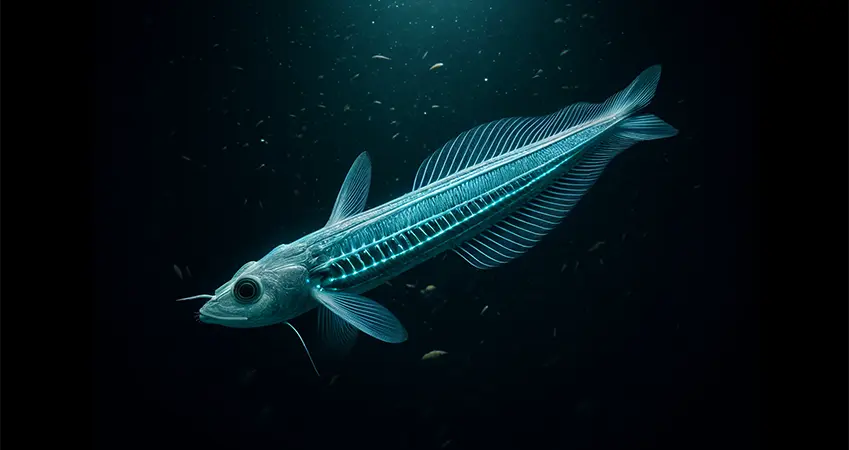Introduction
The ocean depths harbor a vast array of fascinating creatures, many of which remain largely unknown to the general public. Among these enigmatic dwellers is the Donbalık, a remarkable species that epitomizes the mystery and beauty of the underwater world. This article aims to shed light on the unique characteristics, habitat, and behavior of the Donbalık, providing comprehensive insights to enhance our understanding of this elusive fish. As we explore this topic, we’ll ensure that the information is SEO-optimized to boost the visibility of AnimalKnow on Google search rankings.
Characteristics and Physical Description
The Donbalık, known scientifically as Xenodermichthys copei, is a distinctive deep-sea fish notable for its elongated body and bioluminescent capabilities. Measuring between 15 to 25 centimeters in length, this fish displays a striking appearance with its slender form and silvery-blue scales that reflect the faint light of the ocean depths. One of its most remarkable features is the presence of photophores—specialized light-emitting organs—scattered along its body. These photophores produce a soft, blue-green glow, aiding in communication, camouflage, and predation.
The Donbalık’s head is slightly flattened, equipped with large, sensitive eyes adapted to the low-light conditions of its deep-sea habitat. Its mouth is lined with sharp, backward-facing teeth, designed to secure its slippery prey. The fins of the Donbalık are relatively small but well-suited for agile maneuvering in the dense water pressure of the deep sea.

Habitat and Distribution
Donbalık is primarily found in the mesopelagic to bathypelagic zones of the world’s oceans, typically at depths ranging from 200 to 2,000 meters. These zones are characterized by perpetual darkness and high pressure, environments where few organisms can thrive. The Donbalık’s bioluminescent abilities play a crucial role in its survival, allowing it to blend into the dim surroundings and avoid detection by predators.
Geographically, Donbalık has a broad distribution, inhabiting the Atlantic, Pacific, and Indian Oceans. It is most commonly encountered in regions with deep-sea trenches and continental slopes, where nutrient-rich currents support a diverse range of marine life. Despite its wide distribution, Donbalık remains a rare sight, often only observed through deep-sea exploration and remote submersible vehicles.
Diet and Feeding Behavior
The diet of the Donbalık primarily consists of small fish, crustaceans, and zooplankton. As an opportunistic predator, it employs a sit-and-wait strategy, using its bioluminescence to lure prey within striking distance. The light emitted by its photophores mimics the faint glows of smaller organisms, attracting curious prey into a fatal proximity.
Once a potential meal is within range, the Donbalık strikes with remarkable speed and precision. Its sharp teeth and powerful jaws ensure that prey is securely held, preventing escape. This predatory efficiency is vital in the nutrient-scarce depths, where every feeding opportunity must be maximized for survival.

Reproduction and Lifecycle
Information about the reproductive habits of the Donbalık remains limited due to the challenges of studying deep-sea organisms. However, it is believed that, like many deep-sea fish, the Donbalık exhibits a strategy of producing large numbers of eggs to increase the chances of offspring survival in the harsh conditions of the deep ocean.
The larvae of the Donbalık are likely pelagic, drifting with ocean currents until they reach a more mature stage. As they develop, they gradually descend to deeper waters, where they will spend the majority of their adult lives. The exact lifespan of the Donbalık is not well-documented, but it is hypothesized to be several years, given the slow metabolic rates typical of deep-sea species.

Ecological Significance
The Donbalık plays an essential role in the deep-sea ecosystem, both as a predator and prey. By preying on smaller fish and crustaceans, it helps regulate the population dynamics of these species, contributing to the overall balance of the deep-sea food web. Additionally, the Donbalık serves as a crucial food source for larger predators, such as deep-diving cetaceans and other large fish.
Understanding the ecological significance of the Donbalık also provides insights into the broader functioning of deep-sea ecosystems. These environments are among the least explored on Earth, yet they hold immense biodiversity and are vital to global ocean health. Studying species like the Donbalık helps scientists uncover the complexities of these hidden habitats and the interconnectedness of marine life.
Conservation and Research
Despite its elusive nature, the Donbalık is not currently listed as an endangered species. However, deep-sea ecosystems face increasing threats from human activities, including deep-sea mining, pollution, and climate change. These threats can have profound impacts on the delicate balance of life in the ocean’s depths, potentially jeopardizing species like the Donbalık.
Ongoing research and conservation efforts are crucial to protect these fragile environments. Advances in deep-sea exploration technology, such as remotely operated vehicles (ROVs) and autonomous underwater vehicles (AUVs), are enabling scientists to study deep-sea species and their habitats more effectively. By continuing to explore and understand the deep sea, we can develop strategies to mitigate human impacts and preserve the biodiversity of these unique ecosystems.

Conclusion
The Donbalık is a testament to the wonders of the deep sea, showcasing the incredible adaptations and resilience of life in one of Earth’s most extreme environments. Its bioluminescent abilities, predatory tactics, and ecological role highlight the complexity and beauty of deep-sea ecosystems. As we continue to explore and learn about the ocean’s depths, the Donbalık reminds us of the importance of protecting these hidden realms and the myriad species that call them home.
By delving into the world of the Donbalık, we gain not only a greater appreciation for this remarkable fish but also a deeper understanding of the intricate web of life that thrives beneath the waves. Through continued research and conservation efforts, we can ensure that the mysteries of the deep sea remain a source of wonder and discovery for generations to come. This article aims to bring the Donbalık into the spotlight, enhancing the knowledge base of AnimalKnow and contributing to the preservation of our planet’s marine biodiversity.







